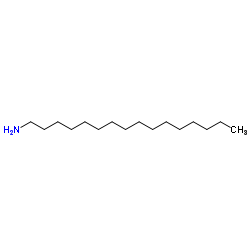Hexadecylamine

Hexadecylamine structure
|
Common Name | Hexadecylamine | ||
|---|---|---|---|---|
| CAS Number | 143-27-1 | Molecular Weight | 241.456 | |
| Density | 0.8±0.1 g/cm3 | Boiling Point | 321.8±5.0 °C at 760 mmHg | |
| Molecular Formula | C16H35N | Melting Point | 38-47ºC | |
| MSDS | Chinese USA | Flash Point | 140.6±0.0 °C | |
| Symbol |


GHS05, GHS09 |
Signal Word | Danger | |
|
A carbon nanotube/poly [Ni-(Protoporphyrin IX)] composite for amperometric detection of long chain aliphatic amines.
Bioelectrochemistry 104 , 51-7, (2015) Poly [Ni-Protoporphyrin] film (pNiPP), containing multiwall carbon nanotubes (MWCNT) was used to cover a glassy carbon electrode. The hybrid material (pNiPP/MWCNT) successfully combines the permselectivity of pNiPP with the high conductivity of MWCNT. The mod... |
|
|
Simple and sensitive progesterone detection in human serum using a CdSe/ZnS quantum dot-based direct binding assay.
Anal. Biochem. 483 , 54-61, (2015) In this study, we developed a CdSe/ZnS quantum dot (QD)-based immunoassay for use in determining the presence of progesterone (P4) in human serum. Hydrophilic QDs were conjugated to anti-progesterone antibody (P4Ab) via ethyl-3-(dimethylaminopropyl)carbodiimi... |
|
|
Ketogenic response to cotreatment with bezafibrate and medium chain triacylglycerols in healthy humans.
Nutrition 31 , 1255-9, (2015) The aim of this study was to compare the ketogenic effect of the peroxisome proliferator-activated receptor-α stimulator, bezafibrate (BEZA), alone or in combination with medium-chain triacylglycerols (MCTs) in healthy adults.Eighteen healthy adults completed... |
|
|
Near-Room Temperature Synthesis of Core/Shell-Structured Quantum Dots.
J. Nanosci. Nanotechnol. 15 , 7146-52, (2015) Core/shell-structured quantum dots (QDs) are considered as important active materials for optoelectronic devices. There have been a lot of synthesis procedures developed so far. Real epitaxial growth of shell layer, however, has not been reported yet. Here, a... |
|
|
New Derivatives of Natural Acyclic Guanidine Alkaloids with TRPV Receptor-Regulating Properties.
Nat. Prod. Commun. 10 , 1171-3, (2015) The guanidine alkaloids, dihydropulchranin A (2), prepared from pulchranin A from the sponge Monanchora pulchra, and hexadecylguanidine (3), a synthetic analog of pulchranins, were studied for their TRPV channel-regulating activities. Compound 2 was active as... |
|
|
Solid Solutions of Rare Earth Cations in Mesoporous Anatase Beads and Their Performances in Dye-Sensitized Solar Cells.
Sci. Rep. 5 , 16785, (2015) Solid solutions of the rare earth (RE) cations Pr(3+), Nd(3+), Sm(3+), Gd(3+), Er(3+) and Yb(3+) in anatase TiO2 have been synthesized as mesoporous beads in the concentration range 0.1-0.3% of metal atoms. The solid solutions were have been characterized by ... |
|
|
Enhancing the photoluminescence of polymer-stabilized CdSe/CdS/ZnS core/shell/shell and CdSe/ZnS core/shell quantum dots in water through a chemical-activation approach.
Langmuir 25(19) , 11732-40, (2009) We report a method for preparing highly photoluminescent, water-soluble CdSe/CdS/ZnS core/shell/shell and CdSe/ZnS core/shell quantum dots (QDs) colloidally stabilized by double hydrophilic copolymers. The polymers, either a diblock copolymer poly(ethylene gl... |
|
|
Microcontact printing onto oxide-free silicon via highly reactive acid fluoride-functionalized monolayers.
Small 6(5) , 642-50, (2010) This work describes a new route for patterning organic monolayers on oxide-free silicon by microcontact printing (microCP) on a preformed, reactive, acid-fluoride-terminated monolayer. This indirect printing approach is fast and easily preserves the oxide-fre... |
|
|
Engineering multifunctional magnetic-quantum dot barcodes by flow focusing.
Chem. Commun. (Camb.) 47(14) , 4195-7, (2011) A simple one-step flow focusing method was used to embed both magnetic nanoparticles and quantum dots in microbeads in controlled ratios to generate a large library of molecular barcodes for biological applications. |
|
|
[Coprecipitation of the Pseudomonas fluorescens lipase with hydrophobic compounds as an approach to its immobilization for catalysis in nonaqueous media].
Bioorg. Khim. 28(1) , 44-9, (2002) The precipitation of N-cetylamine, N-cetylacetamide, hexan-1,2-diol, cetyl alcohol, and poly(butyl metacrylate) in acetone-water media in the presence of the lipase from Pseudomonas fluorescens was found to be accompanied by the coprecipitation of the enzyme.... |